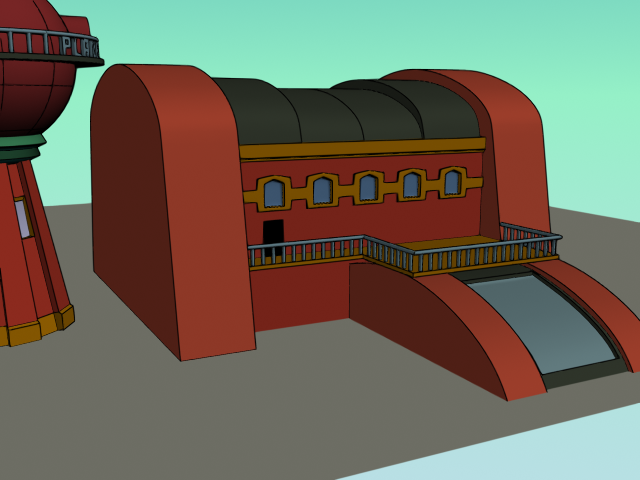Ever feel like you don’t have enough time? More and more, I feel like there are not enough hours in the day.
In college, all I had was time. In fact, I had far too much of it. I wasted hours a day watching TV, playing video games, and just generally screwing around.
After graduating, I still had a lot of free time (or so I remember). But each successive year, it seems like I have less time to myself to just relax. Being busy isn’t necessarily a bad thing; it’s better than being bored. But it would be nice to have more time to focus on the things that I want to keep me busy, rather than the things that I have to get done.
“And you run and you run to catch up with the sun, but its sinking,
Racing around to come up behind you again.”
– Pink Floyd, “Time”
I stumbled on an interesting article about problems with Microsoft Vista’s new content protection elements. It’s pretty long and can get technical in some parts, but here’s the basic summary: Microsoft, in cahoots with major media moguls (Hollywood studios, record labels, etc.) has designed their newest operating system (Vista) with a paranoid level of safeguards against pirating. The “protections” are so restrictive that many users may find that they cannot watch or listen to content that they legally purchased (and this has already become an issue for some users).
Even if you are lucky enough to be able to view the content, Vista may still downgrade the quality without telling you. So even though you may be watching a HD-DVD source disk, the actual image quality may have been downgraded to that of a regular DVD.
The article lists other issues with the new content protection system. Drivers have to be signed by Microsoft (a very cumbersome process) in order to work 100% with the OS, otherwise the device it controls will be crippled (imagine that you buy the latest video card but Vista won’t let you view movies on your screen). All protected media content has to be encrypted within the computer, forcing the CPU to decode a video stream and then immediately encrypt it, which will put excessive demands on the CPU (if it’s even possible on your computer). Of course, all of this protection is geared towards media – Microsoft doesn’t really care if your personal information, like passwords, is protected or not.
The bottom line for the average user is that a computer will now cost more because of hardware development costs, increased hardware requirements just to run the operating system, and when all is said and done there is no guarantee that their computer won’t run into problems because a Microsoft software update breaks functionality that it deems “unsafe”.
More advanced users will probably have no problems getting around these issues by circumventing the entire protection system. It will probably take hackers days to break Microsoft’s various protection schemes (which is common – MS has had a host of problems with their existing DRM), but most users won’t know enough to take advantage of those hacks. Once again, in the war against piracy, it will be the common user that loses.
An operating system should enable a user on his computer, not interfere with the user’s ability to work with the data on his system. If Microsoft continues down this path, it will see consumer market share decline sharply. More and more users want to be able to view and create content on their computers, and if Microsoft interferes with those features then users will be willing to pay a little more, get an Apple, and get exactly what they want.
Personally, I like the Windows XP OS. It’s pretty stable (relative to the other Windows versions, although 2000 wasn’t too bad) and very easy to use. The ease-of-use was the key selling point for Windows that made it so popular. Apple has stepped up to the plate and created an interface that can rival Windows, so Microsoft no longer has the luxury of being the only choice on the menu.
On a final note, a few months ago Steve Jobs posted an open letter on DRM, explaining Apple’s business stance on the DRM it uses in iTunes. He goes on to say that if the studios would give consent, Apple would gladly do away with its DRM. It’s interesting to see the difference in philosophies between Apple and Microsoft. PCs used to be a totally open hardware specification, which differentiated it from Apple’s closed model. Now, Apples run on PC hardware (although still tightly controlled) while PCs are in threat of conforming to Microsoft’s (and the Hollywood studios’) specific demands.
I’ve never owned an Apple computer; in fact, the only times I’ve used one is helping someone else to figure out how to create and manage media files. But if this keeps up, I may have to finally give up on Microsoft and make the switch. I guess I’ll be watching Vista closely to see how this goes (and holding on to XP for as long as I can!).
Well, it’s been a while since I posted. Again. I’ve been busy with work, wedding plans, and University State. Not a good excuse, since a post doesn’t take that long to write, but there isn’t much new to report.
I spent Sunday night reading up on some interesting information on frame rate encoding in MPEG-2 files on DVDs. Commercial DVDs that are transferred from film (film = 24 fps) can be encoded into the DVD MPEG at 24 fps, with extra flags encoded in to instruct the DVD player to correctly and easily convert the video to the US television standard, NTSC (NTSC = 30 fps). And the 24 fps MPEG gets encoded with progressive frames rather than interlaced, which further improves the quality (as long as the source was originally 24 fps). For those of you technically inclined, check out these links:
http://www.dvdfile.com/news/special_report/production_a_z/3_2_pulldown.htm
http://www.hometheaterhifi.com/volume_7_4/dvd-benchmark-part-5-progressive-10-2000.html
http://mediasoftware.sonypictures.com/support/productinfo/24p.pdf
On a different topic, check out the amazing CGI work at the end of this 30 second clip. I wonder how much the special effects company got paid!
http://www.youtube.com/watch?v=YozMDzOAGxk
Finally, production on University State is moving along, although my work has been slower than I expected. The combination of my recently busy schedule and the learning curve for animating in LightWave have limited my output so far to one complete scene, plus the storyboard and initial animating of a second. Not bad, but hopefully the speed will pick up as I get better.
I did a little work last week on the Planet Express model that I’m doing for fun. Here are the latest renders. I still haven’t finished the basic modeling and I also have to spend some time improving the textures of everything, especially the windows.



Last week I posted a new entry to my gallery, which was an attempt at a photo-realistic render of a melting ice cube and a glass. I’m very happy with the results, although I feel like I still need some work on lighting. Check it out in the gallery.
After I finished that piece, I started working on a new side project: the Planet Express building from Futurama. This will let me try out my skills with creating a cartoon-like setting. Futurama was partly created in 3D (the shots I’m using as reference were completely created in 3D, I think), so it’s a great level to strive for. My current progress is posted below.
Finally, production on University State ep. 4 has started and that will be taking up more of my free time. You can check out more details at Pi Visuals as they are released.

Apparently a marketing campaign for Aqua Teen Hunger Force went horribly awry when some concerned citizens in Boston mistook a circuit board with lights in the shape of Ignignokt (a minor but popular character from the show) for a bomb.
http://www.usatoday.com/news/nation/2007-01-31-boston_x.htm
The city mobilized their bomb squad and anti-terrorism units, shut down major roads, subways, and a river, and spent between half a million and a million dollars battling this “threat”. And now the mayor is trying to lay suit to Turner Broadcasting, threatening to sue to have their broadcasting license revoked or suspended. And two employees of the marketing firm that were hired to place the advertising units have been arrested and are being charged with crimes that could include jail time.
Could Turner have handled this better? Yes, all they had to do was notify the cities in advance. Is the Boston mayor overreacting to garner publicity for himself? Yes, because he is embarrassed that his city spent close to a million dollars to clean up a few dozen Lite-Brites.
I wish I found one of them here in Chicago – it would hanging in my office right now lighting up my room.

Wow, my last post was before Christmas! Shame on me!
The holidays were crazy busy for me. Aside from the usual hustle and bustle of Christmas and New Years, there have been a lot of friends visiting from out of town which demanded a lot of free time (although I’ve been having a lot of fun). Then, last week, I came down with a bad cold, which has knocked me out for a while. But I’m on the up-swing, so hopefully in a few days I’ll be back to 100%.
In the little spare time afforded to me, I have started to step up and take a more active role in the pre-production of the next episode of University State. Once production starts (sometime within the next week or two), I expect to take on a much greater share of that, as well. Aside from helping create and document the formal pipeline that will be used, I’ve been working on a new character model for the episode. You’ll get to see it once the episode is released (what a teaser, since the release isn’t expected for months!), unless the creator decides to slip out a few images during the production.
I’m finally finished with my first model. I’ve put her on the shelf and moved on to newer projects. I created a (very) short animation to test out the controls where she jumps up and lands. I shot the same animation using two different cameras, one using a full shot and the other with a medium.

 (click on the images to the left to view the two short clips)
(click on the images to the left to view the two short clips)
Well, I finally finished my first character model, rigging and all. I originally created the character without clothes, weight-mapped her, and rigged her in Layout. I spent this past week reworking the model to include clothes. I’ll have a finished image or sequence out very soon.
In the meantime, I’ll be working on a new model that will get used in the next episode of University State (the fourth – the third is finishing up post-production this week). I’m hoping that this model will go much faster than the first, now that I have the experience of making a model plus I can use my first model as a basis for creating the second one.
A little less than two months ago, I said that I was going to try using a biphasic sleep schedule to cut down my sleep time to about six hours a day. My experiment with that schedule is over and I will share my results, since one of my frustrations with researching sleep schedules online was that people promised to start a schedule, then it seemed like they stopped for no apparent reason.
As I said, my goal was to cut down my sleep to six hours a day by splitting my sleep time into two blocks: a main (“core”) block at night for 4.5 hours and a nap in the late afternoon for 1.5 hours. This schedule is called biphasic because there are two blocks of sleep per day. Both blocks are whole multiples of 1.5 hours so I finish sleeping at the end of a sleep cycle, maximizing the effectiveness of the sleep block.
Before this experiment I was already in a biphasic schedule, but the core block was usually 7 to 8 hours and the nap ranged from 45 minutes to 3 hours. I think the most successful component of this new schedule was identifying my sleep cycle and changing my blocks around that 1.5 hour multiple. Since recognizing that cycle time, Ive noticed that whenever I wake up on my own in the morning, after my nap, or even in the middle of the night briefly, it’s almost always in 1.5 hour increments from when I drowsed off.
The attempt for 6 hours of sleep a day failed. I was tired during the day and my naps often extended into 3 hours because I was wiped out from not getting enough sleep during my core block. On weekends I slept even longer, because I was still catching up on my sleep debt. Ultimately, I loved the fact that I was able to stay up so late at night, but the trade-off was a loss of alertness and productivity the next day.
Accepting that I need more sleep, I’ve slightly adjusted my schedule and finally found a good balance. I’m still sticking to a biphasic schedule because that is what works best for me (I have always loved naps and, for me, they are an essential part of keeping my energy levels high throughout all of my waking hours). However, now my core block is 6 hours long and my nap is 1.5 hours long. I’ve found that keeping my blocks in multiples of 1.5 hours maximizes the effectiveness of the sleep.
Extending my core block keeps me awake and alert during the day at work, because I’m well rested from the night before. After work is over, I’m able to take my nap and I usually only sleep for 1.5 hours, rather than crashing hard for 3 hours. After that, I’m still able to stay up pretty late and be productive. And my total sleep time is usually 7.5 hours (sometimes on the weekends my core block will extend to 7.5 hours, pushing the day’s total to 9 hours if I’m able to get a nap in).
In conclusion, I’m still a supporter of biphasic sleep and especially of trying to time your sleeping times to coincide with the end of sleep cycles. However, you need to recognize your sleep requirements and meet them. In my case, I need 7.5 hours of effective sleep a day.
Finally, a quick note on naps. If you are able to get in that long 1.5 or 3 hour nap, you’ll probably wake up a bit groggy. That clears after 15 minutes or so, but it is called sleep inertia. Even though you have to deal with a second tough wake-up by taking that long nap, that sleep does get added to your total for the day and you’ll see a raise in energy and alertness for at least 4 hours (if you are caught up on your sleep). If, however, you are short on time for a day and suddenly find that you can’t take that nap you have been looking forward to, go ahead and take a 20-30 minute nap to recharge yourself. It won’t help much with your sleep debt (you’ll still need to make up that missed nap), but that nap will give you a boost in energy for a couple of hours.
Just don’t try taking a nap for more than 40 minutes and less than the full 1.5 hours. You’ll end up waking up with worse sleep inertia than the full 1.5 hours and it will be less effective than either of the two alternatives.








